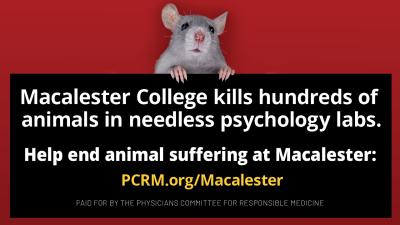EPA Releases New List of Nonanimal Approaches That Can Replace Animals in Chemical Testing

On Dec. 5, the Environmental Protection Agency (EPA) released an updated version of its List of Alternative Test Methods and Strategies (or New Approach Methodologies [NAMs]).
The EPA and other regulatory agencies around the world have begun to use “New Approach Methodologies (NAMs)” to refer broadly to any nonanimal technology, methodology, approach, or combination thereof that can be used to provide information on chemical hazard and risk assessment. Here at the Physicians Committee, we like the clarity that the term provides. Some people may think that using the word “alternative” to describe a nonanimal test implies that the animal-based method or approach is the standard and that nonanimal testing methods are a less-desirable “alternative.”
The newly released list contains links to test guidelines, method protocols, computational tools, and databases, guidance, and policies from the EPA that "do not use vertebrate animals to develop new data/information," and additional guidance or other documents that are considered "tools and approaches which may enhance the use of NAMs for regulatory use under TSCA [the Toxic Substances Control Act]."
The EPA is required by the Frank R. Lautenberg Chemical Safety Act for the 21st Century to maintain and regularly update a list of NAMs to ensure scientists at the EPA and at chemical companies are able to avoid animal tests to the greatest extent possible. The Physicians Committee played a role in instituting these requirements in the legislation, and we are pleased to see the EPA publish an updated list on an annual basis.
New additions to the already-comprehensive list include:
- The ToxCast Estrogen Receptor Agonist Pathway Model, which uses activity patterns across multiple in vitro assays and a computer-based data analysis model to predict whether a chemical is an ER agonist or antagonist, or is otherwise influencing the estrogen pathway in a way that might cause toxicity.
- In vitro BALB/c 3T3 Cell Transformation Assay, an in vitro cell transformation assay (CTA) proposed as an alternative to in vivo carcinogenicity testing.
- Determination of in vitro intrinsic clearance using rainbow trout hepatocytes (OECD TG NO. 319A) and Determination of in vitro intrinsic clearance using rainbow trout liver S9 sub-cellular fraction (RT-S9) (OECD TG NO. 319B) which can both be used to assess whether chemicals bioaccumulate in fish.
- Several guidance documents related to avoiding testing, or alternative approaches for, acute systemic toxicity, eye irritation, skin sensitization, and endocrine disruption.
- NAMs reviewed and reported on by an EPA Science Advisory Panel related to on endocrine disruption, respiratory toxicity, and the EPA CompTox Chemicals Dashboard.
To learn more about these guidelines, New Approach Methodology (NAMs) Use for Regulatory Application (NURA) offers training, seminars, and other events to promote the use of NAMs within various regulatory frameworks, domestically and internationally.
The Physicians Committee works through NURA to directly provide government agencies and industry the resources and training needed to increase the use of NAMs required by the Lautenberg Act and by the EPA’s recent commitment to end reliance on mammalian testing by 2035..
Interested in working on these issues? We’re hiring a Regulatory Testing Analyst to help promote NAMs for chemical and pharmaceutical testing!







